#iguanodon bernissartensis
Photo

One more charcoal practice, featuring two bull Iguanodon fighting. I had one of those miraculous shower thoughts while thinking about this animal that we’ve known about for almost two centuries and yet we’re still not quite sure what it used those ridiculously humongous thumb spikes for.
The idea came from the Dreadnoughtus sequence in Prehistoric Planet s01, where Attenborough informs that the animals were using their own singular thumb claws to try to wound their rival while fighting (btw it’s my FAVORITE segment in the whole documentary). And I thought, if it’s plausible sauropods did it, why not the ONE ORNITHOPOD that evolved such enormous and conspicuous spikes on their hands?? Honestly, I could write a whole rant on why I believe this is the most plausible use for them based on what paleontologists know so far, but in the end, I’m still just a student. What do I know, really?
Anyway, now that I’m getting the hang of charcoal, I might move on to pastels next. I want to see what I can do with them. Truth be told, gouache and I aren’t getting along too well. Watercolors are getting too limiting for me. Coloring pencils are fun, but pastels... There’s something about them I want to explore (thanks Doug Henderson, your gorgeous paleoart got me into this).
Soon I’ll be posting a scanned version of this piece on dA, just gotta wait until it stops raining so I can take it to the print shop.
Skeletals consulted for this piece by: Dr. Scott Hartman and Henrique Paes (https://www.deviantart.com/randomdinos)
Find me on deviantArt and twitter
#palaeoblr#dinosaurs#paleoart#iguanodon bernissartensis#artists on tumblr#charcoal#dinosaur art#palaeoart#extinct fauna#prehistoric fauna#mesozoic#my art
75 notes
·
View notes
Text
Dinofact #115
Many species, hailing from the late Jurassic Period to the early Cretaceous Period of Asia, Europe, and North America, have been classified as Iguanodon. After taxonomic revision and the naming of a few new species, Iguanodon is now based mainly on one well-substantiated species, I. bernissartensis. This species lived in the early cretaceous in England, Germany, Belgium, and Spain, and possibly other European countries.
Source: Wikipedia
#dinosaur#dinosaurs#paleontology#taxonomy#iguanodon#iguanodon bernissartensis#i. bernissartensis#europe#fun facts#trivia#dinosaur trivia#dinosaur fun facts#1st#january#2023#january 1st#january 2023#january 1st 2023
13 notes
·
View notes
Text

"What is to come"
(image id is both in the alt text and below the read more- I put it under one because it's incredibly long)
And so there we have it, the 200+ followers artpiece that I have been working on for several days, if I had to guess I'd say it took 25 or so hours over eleven days. Honestly it's so surreal to me that I'm here with over 200 followers (260 as of typing this- yes, I procrastinated on this), especially when I only hit 100 followers in February. It's genuinely really nice to know that people are actually interested in my art (before anyone brings up spam bots- I know there are a few of them amongst my followers but I've checked most of them and I am 100% confident that over 200 of them are real). I don't really have much else to say really- I'm just grateful to have the support. Thanks y'all :).
[Image id: a large, lineless digital drawing of several dinosaurs. It is nighttime. At the bottom of the piece, a lone Eoraptor lunensis is walking across the floodplains- both the ground and the Eoraptor are just silhouettes, the early dinosaur has been given protofeathers. The full moon is shining, it's size is exaggerated for artistic affect. Behind the moon, the heads of sixteen different dinosaurs can be seen (listed left to right, bottom to top) Row 1- Thecodontosaurus antiquus (small sauropodomorph with light brown protofeathers, near-white undersides, straight stripes that are moderately darker than the base colour and vibrant green eyes), Coelophysis bauri (small early theropod with a long and narrow skull, its protofeathers are golden and black. A soft orange stripe runs across the back of its head, it has warm brown eyes. Row 2- Plateosaurus trossingensis (long-necked sauropodomorph, it has reddish-brown scales, light undersides, triangular stripes running down it's spine that get bigger the further down they get and pale yellow eyes), Heterodontosaurus tuckii (small ornithopod with a hooked grey beak. It has spiky green feathers, a lighter chest and a darker stripe running along its head and back, there are three small spots on its face, two behind the eye and one infront of it, it's eyes are bright yellow). Row 3- Megalosaurus bucklandii (medium-sized theropod with warm brown feathers, lighter undersides, dark spots and bright yellow eyes, there are several scars on its face), Brachiosaurus altithorax (greenish-grey true sauropod with lighter undersides, a dark pink patch on its throat, dark desaturated brown eyes and a few small scars on its neck), Archaeopteryx (early toothed bird with a black head, white neck and bright yellow eyes). Row 4- Hylaeosaurus armatus (pale brown ankylosaur with lighter undersides and vibrant green eyes), Velociraptor mongoliensis (dromaeosaur with light brown feathers, a lighter chest, a black stripe near its eye and light green eyes), Sinosauropteryx prima (small compsognathid theropod with ginger protofeathers, an off white mask and undersides and pale yellow eyes), Iguanodon bernissartensis (large greenish-grey ornithopod with a slightly darker back, pale undersides, a grey beak, and yellow eyes). Row 5- Matuku otagoense (heron with medium grey feathers and a small crest. A red stripe runs from just behind its nostrils to about a third of the way down its neck. Its undersides are white, its beak is grey and its eyes are brown), Triceratops prorsus (three-horned ceratopsian with grey-brown scales, lighter undersides, two triangular stripes between it's brow and nasal horns, reddish-orange diamond-like stripes on its frill, a hooked grey beak and golden eyes. Its brow horns curve forward at the base. Row 6- North Island brown kiwi (plump brown bird with a long pale beak, whiskers and black eyes, its nostrils are at the tip of its bill, and unlike the other dinosaurs in the sky part of its body below the neck is visible), male house sparrow (small redish-brown and grey bird with a black bib below it's bill), it has brown eyes and a dark grey bill. Row 7- rock dove (grey bird with iridescent green feathers scattered across its neck, a dark grey beak, and warm brown eyes). end id]
#art#my art#digital art#paleoart#dinosaurs#birds#eoraptor#thecodontosaurus#coelophysis#plateosaurus#megalosaurus#brachiosaurus#archaeopteryx#hylaeosaurus#velociraptor#sinosauropteryx#iguanodon#matuku#triceratops#north island brown kiwi#house sparrow#rock dove
27 notes
·
View notes
Text
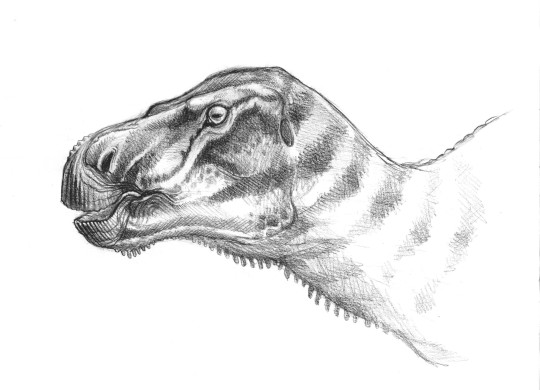
Iguanodon bernissartensis portrait - pencil on paper
513 notes
·
View notes
Text
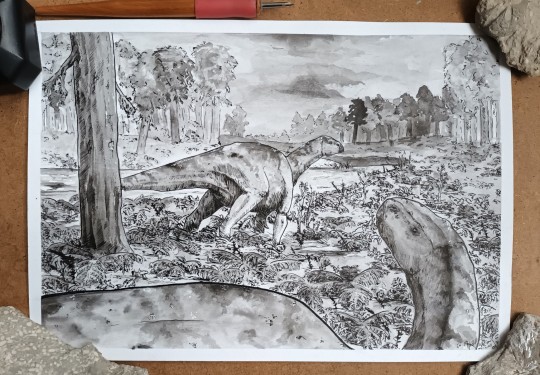
Iguanodon bernissartensis
Drew this illustration based on the iguanodons of Bernissart (Belgium) and the Bernissart formation.
#drawing#art#paleoart#palaeoblr#dinosaurs#dinosaur#paleontology#palaeontology#ink#pen and ink#iguanodon#illustration#seeing these fossils irl is still on my bucket list
45 notes
·
View notes
Text
Iguanodon bernissartensis, drawn on an empty page I missed in my sketchbook.
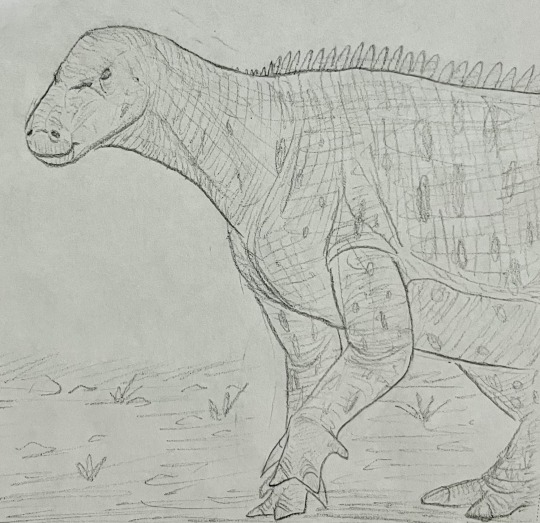
@1dinodaily
12 notes
·
View notes
Note
whats your favourite dinosaur and why??
The one that looks like this:
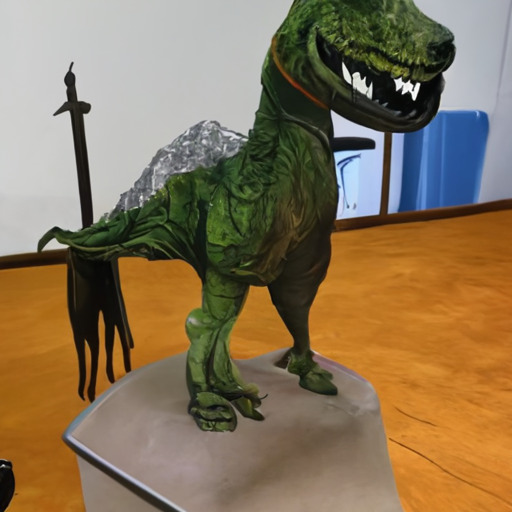
Basically because he's a silly guy. He's a hadrosaur and the first dinosaur I got excited about when I learned about them as a kid. Also because he was the first dinosaur I ever got to see in person, and the first one that I ever actually saw off-screen -- the late Paul Sereno went on a lecture tour when I was in grade school and showed us a video of one of his paleontologists discovering a field of fossils in Niger, including this guy.
The video opened with a female paleontologist discovering the skull of this guy's head, in which you could see some of the individual bones. I remember I was at home with a babysitter and I ran upstairs to my mom to tell her about it, because I had never seen such a complete skull fossil before. (That is also when I came to appreciate the centrality of the skull to a human being's personality. The only time I cried in childhood was when we had to put our dog down, but I didn't start crying until I saw the animal's skull).
Anyway, like, officially official name for this guy is Iguanodon bernissartensis, named for the Bernissart cave in Belgium where these specimens were found.
#i took this picture when i was really little so i didn't realize the eggs and skulls were fake#or maybe i realized but didn't give a shit#though i do have a fondness for skulls#scribonia-art#computer generated image#guidance scale 4
23 notes
·
View notes
Text
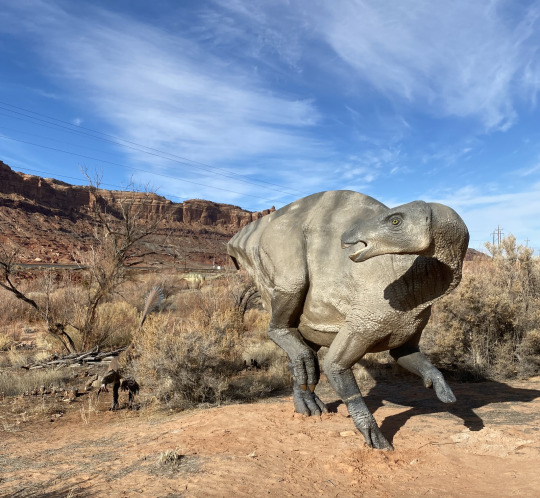
iguanodon bernissartensis menaced by deinonychus antirrhopus peeking around a bush

3 notes
·
View notes
Text




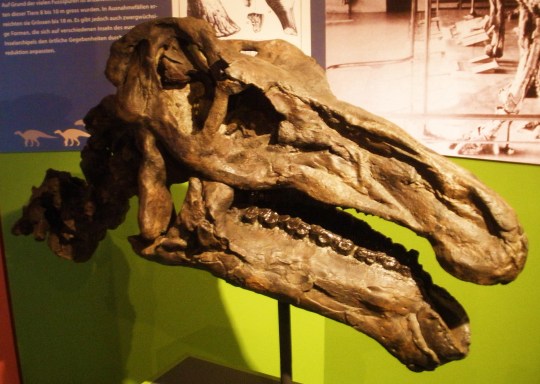

Iguanodon
(temporal range: 126-122 mio. years ago)
[text from the Wikipedia article, see also link above]
Iguanodon (/ɪˈɡwɑːnədɒn/ i-GWAH-nə-don; meaning 'iguana-tooth'), named in 1825, is a genus of iguanodontian dinosaur. While many species found worldwide have been classified in the genus Iguanodon, dating from the Late Jurassic to Early Cretaceous, taxonomic revision in the early 21st century has defined Iguanodon to be based on one well-substantiated species: I. bernissartensis, which lived during the Barremian to early Aptian ages of the Early Cretaceous in Belgium, Germany, England, and Spain, between about 126 and 122 million years ago. Iguanodon was a large, bulky herbivore, measuring up to 9–11 metres (30–36 ft) in length and 4.5 metric tons (5.0 short tons) in body mass. Distinctive features include large thumb spikes, which were possibly used for defense against predators, combined with long prehensile fifth fingers able to forage for food.
The genus was named in 1825 by English geologist Gideon Mantell but discovered by William Harding Bensted, based on fossil specimens found in England and was given the species name I. anglicus. Iguanodon was the second type of dinosaur formally named based on fossil specimens, after Megalosaurus. Together with Megalosaurus and Hylaeosaurus, it was one of the three genera originally used to define Dinosauria. The genus Iguanodon belongs to the larger group Iguanodontia, along with the duck-billed hadrosaurs. The taxonomy of this genus continues to be a topic of study as new species are named or long-standing ones reassigned to other genera. In 1878 new, far more complete remains of Iguanodon were discovered in Belgium and studied by Louis Dollo. These were given the new species I. bernissartensis. In the early 21st century it became understood that the remains referred to as Iguanodon in England belonged to four different species (including I. bernissartensis) that were not closely related to each other, which were subsequently split off into Mantellisaurus, Barilium and Hypselospinus. It was also found that the originally described type species of Iguanodon, I. anglicus was a nomen dubium, and not valid. Thus the name "Iguanodon" became fixed around the well known species based primarily on the Belgian specimens. In 2015, a second valid species, I. galvensis, was named, based on fossils found in the Iberian Peninsula.
Scientific understanding of Iguanodon has evolved over time as new information has been obtained from fossils. The numerous specimens of this genus, including nearly complete skeletons from two well-known bone beds, have allowed researchers to make informed hypotheses regarding many aspects of the living animal, including feeding, movement, and social behaviour. As one of the first scientifically well-known dinosaurs, Iguanodon has occupied a small but notable place in the public's perception of dinosaurs, its artistic representation changing significantly in response to new interpretations of its remains.
5 notes
·
View notes
Photo

Postcard of the Bernissart Iguanodon fossil (1920).
110 notes
·
View notes
Photo

In the interests of posting something other than 24-hour comic pages, here’s yet another character from the project that I’ve been gradually posting characters from over the last... year or so?
#dinosaur#iguanodon#Don Gedeón#The Very High Seas#character#character design#animation#Iguanodon bernissartensis
4 notes
·
View notes
Photo
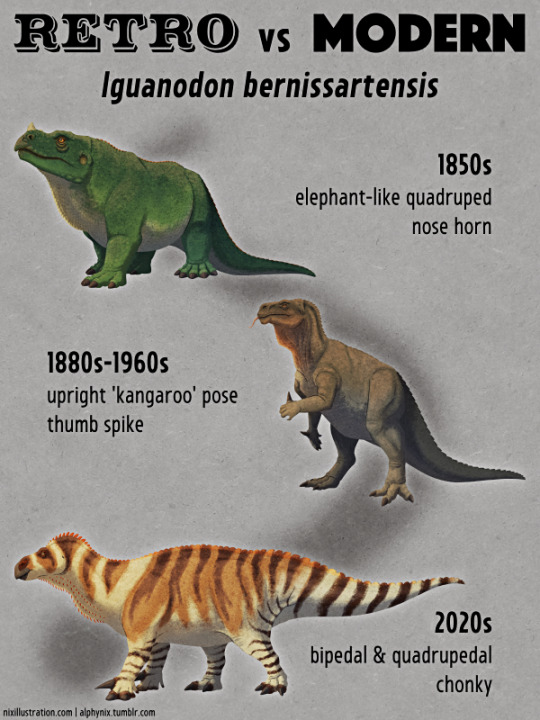
Retro vs Modern #02: Iguanodon bernissartensis
Named just a year after Megalosaurus, in 1825, Iguanodon has remained a fairly iconic dinosaur ever since.
Discovered in a different region of Southeast England, its fossilized teeth were soon recognized as being similar to those of modern iguanas – but much much larger. Partial skeletal remains were initially reconstructed as belonging to a gigantic herbivorous lizard, with what was thought to be a horn placed on the tip of its nose.
1850s
The Victorian Crystal Palace statues of Iguanodon depicts a more bulky reptile with a nose horn, a toothless beak at at the front of its jaws, scaly skin, thick upright legs and hoof-like claws. Much like the Megalosaurus of the time it's really not nearly so bad of a reconstruction as it's often accused of being, showing a surprisingly naturalistic and almost mammal-like interpretation of these animals compared to later portrayals.
Technically the particular "Iguanodon" species at Crystal Palace has more recently been renamed Mantellisaurus atherfieldensis, but it was considered to be Iguanodon at the time so it's included here anyway.
1880s-1960s
A massive discovery of the remains of nearly 40 Iguanodon individuals in a coal mine in Bernissart, Belgium, revealed the full anatomy of these dinosaurs for the first time. Much more well-preserved and complete than the patchy English material, these larger Iguanodon bernissartensis eventually became the official type species for the whole genus – a standard used to help determine whether similar-looking fossils are Iguanodon or not.
The Bernissart specimens were restored as bipedal animals in an upright kangaroo-like pose, with their tails dragging behind them acting like a tripod to prop them up. What had previously been the single "horn" was finally realized to instead be a thumb spike on each hand, interpreted as a defensive weapon against predators.
This image of Iguanodon persisted for decades, with a giraffe-like long prehensile tongue sometimes also depicted (including a particularly bizarre interpretation of it sticking out through a hole in the lower jaw!).
2020s
The Dinosaur Renaissance in the late 20th century corrected Iguanodon's posture to hold its body horizontally, and it was eventually recognized as being capable of both bipedal and quadrupedal movement. Juveniles were found to have walked more on their hindlimbs, while adults spent more time on all fours but were still capable of running bipedally when they needed to.
We now have fossils of Iguanodon from across much of Europe during the Early Cretaceous, about 126-122 million years ago. Our modern view of this animal is a heavily built ornithopod that grew to around 9m long (~30'), with a horse-like head, a large keratinous beak at the front of its jaws, chewing teeth further back, and cheeks covering the sides of its mouth. Its chunky forelimbs each had a large thumb spike, hoof-like claws, and a prehensile grasping pinky finger, while its powerful hindlimbs ended in three-toed vaguely bird-like feet.
Soft tissue preservation discovered in related hadrosaurs suggests it probably also had a very bulky body with a thick heavily muscled neck and tail, and possibly an ornamental "frill" running along its back. Skin impressions show a covering of numerous tiny pebbly scales, generally too small to have been visible from a distance.
———
Nix Illustration | Tumblr | Twitter | Patreon
#retro vs modern 2022#science illustration#paleontology#paleoart#palaeoblr#iguanodon#iguanodontia#ornithopoda#ornithischia#dinosaur#art#retrosaurs#the one thing all versions here agree on is that back frills and dewlaps are neat :)
1K notes
·
View notes
Photo


Iguanodon bernissartensis, National Museum of Natural History, Paris, France
424 notes
·
View notes
Photo

Iguanodon bernissartensis carrying material to build a nest and a little ant crossing its path with a leaf.
351 notes
·
View notes
Photo

Is a genus of ornithopod dinosaur that existed roughly halfway between the first of the swift bipedal hypsilophodontids of the mid-Jurassic and the duck-billed dinosaurs of the late Cretaceous. While many species have been classified in the genus Iguanodon, dating from the late Jurassic Period to the early Cretaceous Period of Asia, Europe, and North America, taxonomic revision in the early 21st century has defined Iguanodon to be based on one well-substantiated species: I. bernissartensis, which lived from the late Barremian to the earliest Aptian ages (Early Cretaceous) in Belgium, Spain, Germany, England, Portugal and possibly elsewhere in Europe, between about 126 and 122 million years ago. Iguanodon were large, bulky herbivores. Distinctive features include large thumb spikes, which were possibly used for defense against predators, combined with long prehensile fifth fingers able to forage for food. The genus was named in 1825 by English geologist Gideon Mantell but discovered by William Harding Bensted, based on fossil specimens found in England and was given the species name I. anglicus. Iguanodon was the second type of dinosaur formally named based on fossil specimens, after Megalosaurus. Together with Megalosaurus and Hylaeosaurus, it was one of the three genera originally used to define Dinosauria. The genus Iguanodon belongs to the larger group Iguanodontia, along with the duck-billed hadrosaurs. The taxonomy of this genus continues to be a topic of study as new species are named or long-standing ones reassigned to other genera. In 1878 new, far more complete remains of Iguanodon were discovered in Belgium and studied by Louis Dollo. These were given the new species I. bernissartensis. In the early 21st century it became understood that the remains referred to Iguanodon in England belonged to four different species (including I. bernissartensis) that were not closely related to each other, which were subsequently split off into Mantellisaurus, Barilium and Hypselospinus. It was also found that the originally described type species of Iguanodon, I. anglicus was a nomen dubium, and not valid. Thus the name "Iguanodon" became fixed around the well known species based primarily on the Belgian specimens. Scientific understanding of Iguanodon has evolved over time as new information has been obtained from fossils. The numerous specimens of this genus, including nearly complete skeletons from two well-known bone beds, have allowed researchers to make informed hypotheses regarding many aspects of the living animal, including feeding, movement, and social behaviour. As one of the first scientifically well-known dinosaurs, Iguanodon has occupied a small but notable place in the public's perception of dinosaurs, its artistic representation changing significantly in response to new interpretations of its remains.
Herbivore
Iguanodon (c) Carnivores: Dinosaur Hunter
Art (c) reneg661
2 notes
·
View notes
Text
Iguanodon


Iguanodons are a genus of herbivorous dinosaurs in the Late Jurassic and Early Cretaceous periods. These dinosaurs were widespread, found in Europe, North and Southern Africa, North America, Australia, and Asia. They are the most well known dinosaur of the iguanodontids. Two accepted species of iguanodon are I. bernissartensis and I. galvensis. The iguanodon was about 30 feet long and approximately 6.5 feet tall at the hip. They most likely grazed on all four feet but were able to walk and stand on two.
Iguanodons had unusual forelimbs with a five fingered hand. The thumb joint was fused into a cone-like spike, the three middle fingers ended as hooflike claws, and the fifth diverged laterally. They had tall and narrow skulls with a beak and teeth similar to an iguanas- although they were much larger and closely packed. Using their teeth, which were developed for grinding, Iguanodons ate low-growing ferns and horsetails. It is believed that these dinosaurs had a cheek-like structure to retain food in their mouths.
All information is from [here] and Wikipedia. Images are not mine.
3 notes
·
View notes